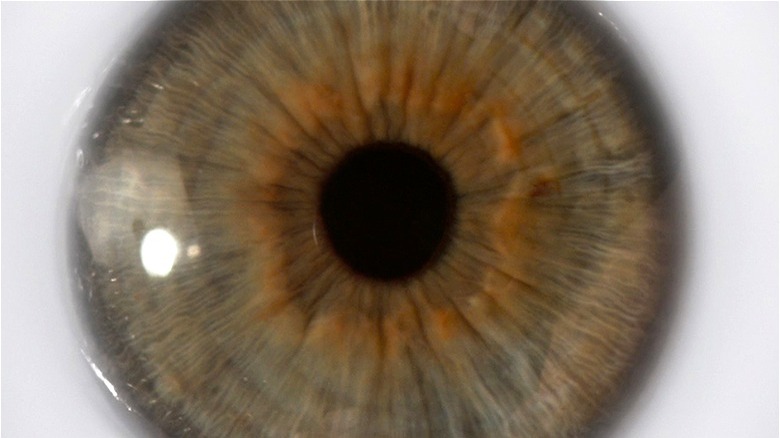Under The Skin's Opening Scene Was A Tribute To The Established 'Language' Of Sci-Fi
In his second full-length feature, "Birth," director Jonathan Glazer employed a subdued, formalist visual language to convey its emotionally messy central themes. However, aesthetics and form are secondary to Glazer, as he seems to be more concerned with the emotional language of a film, which steers visual language, and not the other way around. This is also the case with Glazer's "Under the Skin" — an unconventional, trailblazing entry in the sci-fi genre — which roots the central character in focus and builds a world around her. To call "Under the Skin" an alien invasion film would indeed be a disservice to its carefully-crafted themes, which encapsulate Glazer's notion about the "other" and what it means to feel alienated, either by circumstance or choice. Diverging from the norm by reveling in guerilla-style filmmaking and carving space for non-actors, "Under the Skin" unfurls a singular perspective with abstract mastery.
Glazer's film, loosely based on Michel Faber's novel of the same name, uses its source material as a mere jumping-off point and takes audacious artistic liberties with the core premise. The film's opening sequence directly establishes the ambitious nature of Glazer's vision, as it opens with an event in space, where a source of light illuminates the blankness of a void and planets align with one another. This event in the pre-title sequence seems part-natural, part-engineered, and the viewer is never given a clear picture of what they're looking at. We hear a woman's voice repeating choice phrases while circular structures fall into place, ultimately forming an iris, which belongs to Laura (Scarlett Johansson).
This opening sequence has elicited comparisons to Kubrickian aesthetics in "2001: A Space Odyssey," especially because it is followed by a motorway shot that mimics the Star Gate experienced by David Bowman. But what exactly did Glazer intend to evoke?
Telling a vivid backstory
"Under the Skin" does not spoon-feed its audience. Instead, the film crafts a bold visual language that answers burning questions without explicitly stating the obvious. There are vast caverns of interpretations to be gleaned from these abstract sequences, and Laura's arc is conveyed via her perception of humanity and the gradual shifts that take place within her. In a 2014 interview with Slant Magazine, Jonathan Glazer talked about conveying Laura's story via the established sci-fi "language," which traditionally involves spaceships or an event in space. By evoking these classic images associated with the genre, Glazer pays homage to this established language and subverts it to etch a backstory for his film's lead:
"...The language of that sequence, I wanted it to feel like the alignment of planets, or the docking of a spaceship — something which, when you sit in the cinema and you watch it, you might be thinking, 'Oh, okay, I know we're going. Of course. I'm in a science-fiction film. That's good. Let's watch these [orbs]. What are they? Are they planets, spaceships?' It's a language that's been beautifully and brilliantly established in the past by other films. And then we take it, and turn it, and suddenly, that isn't a planet, that isn't a spaceship, that's an eyeball."
The alignment of the spheres, which leads to the formation of the iris, can be interpreted as Laura's birth or her arrival on Earth, but also allude to some sort of alien correspondence. Glazer called Laura a "Trojan Horse" who functions as our focal point, which ties into the fact that her surreptitious disguise is meant to lure unsuspecting men into a void, from which there is no return. The opening sequence serves to visually reveal Laura's intentions while portraying the alien, otherworldly nature of her origins.
Mirrors are gateways to self-consciousness
In the Slant interview, Jonathan Glazer remarked that "Under the Skin" is about "looking," as the film dives deep into an alien being's perception of the human race. Feminist interpretations of the narrative succinctly point to Laura reclaiming her onus by shifting the lens of objectification away from her, despite the fact that she was created solely to seduce. This process begins with her perceiving her victims to gradually perceiving herself: starting from a superficial make-up check to a more intimate bodily self-exploration, and finally, looking inward.
Mirrors are traditionally portals to alien realms in sci-fi. Although reflective surfaces are a part of an alien consciousness in the film, they also become vehicles of self-reflection and empathy. In a seminal scene, Laura scrutinizes herself in the mirror before letting go of a disfigured man she had lured. Here, an act of self-scrutiny is followed by a transformative act of empathy, which is an "un-programmed" aspect of her function, but an organic one nonetheless. This naturally creates a schism in her identity, to the point that her very existence in this evolved form becomes an act of transgression.
Beneath all of these dense emotional layers lies an acute sense of alienation. With Laura's self-consciousness, the need to belong heightens, but the gap between who she wants to be and who she is meant to be widens with time. Laura meets a tragic end, not allowed to exist in her true form once the layers of skin are cruelly peeled away. Now that she has finally understood her place in the human world and reclaimed her true sense of being, humanity rips it away from her. Laura disintegrates. The void beckons.


